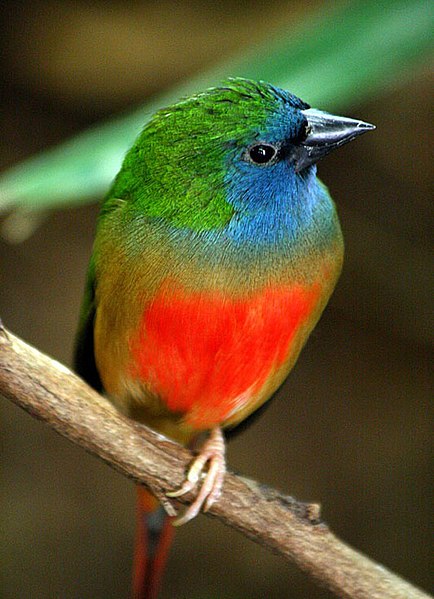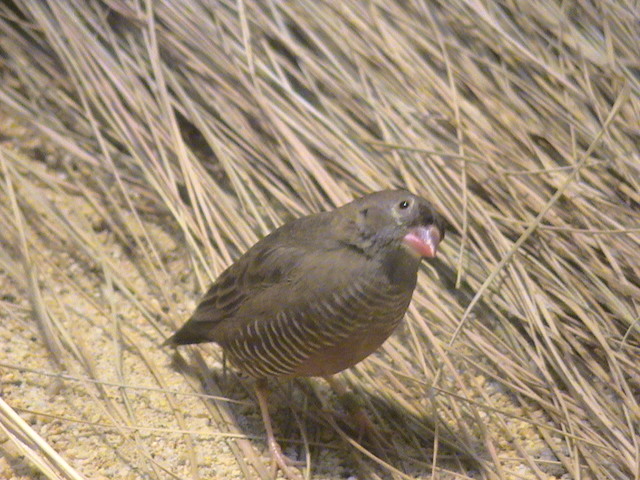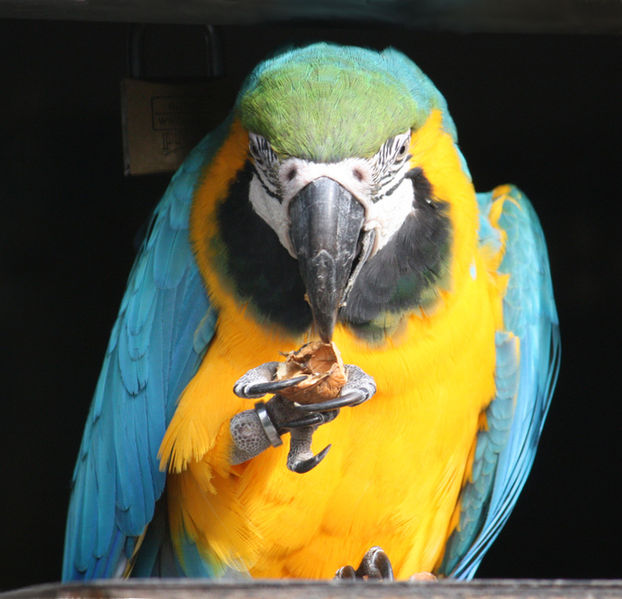Finch enthusiasts are in the enviable position of being able to easily obtain a wide range of interesting, colorful and unusual species. Among no other group of cage birds do we find such a variety of captive-bred specimens. Although some are quite delicate, even those relatively new to the hobby can find a great many hardy species. Today I’d like to provide a look at some of the possibilities.
Bicheno’s or Double-barred Finch, Stizoptera bichenovii
 Measuring a mere 3 inches in length, this delightful little bird is the smallest of the Australian grass-finches. It inhabits grasslands, parks and gardens; wild and captive individuals alike are quite comfortable around people.
Measuring a mere 3 inches in length, this delightful little bird is the smallest of the Australian grass-finches. It inhabits grasslands, parks and gardens; wild and captive individuals alike are quite comfortable around people.
Bicheno’s finch is clad in browns, fawn and gray, and the buff colored face is outlined with a dark, almost heart-shaped ring – bringing to mind a minute barn owl (well, actually I’m referring here to my mind, I’ve not had others second that opinion!). Despite its diminutive size, this finch is quite steady in disposition, and makes a fine, always curious pet.
These finches are much inclined to scratch about the ground for insects…providing a pile of leaf mulch will keep them occupied and yourself amused for hours.
Pin-tailed Nonpareil, Eurythrura prasina
 Clad in green, blue and bright red, this most desirable of the parrot finches occurs from Myanmar to Java.
Clad in green, blue and bright red, this most desirable of the parrot finches occurs from Myanmar to Java.
Nonpareils are bred in large numbers, but remain a species best kept by well-experienced aviculturists. They are fairly high strung and tend to crash into walls and cage bars when startled. For that reason, they are best kept in spacious, well-planted aviaries. For some reason, males greatly outnumber females, and hence true pairs are difficult to obtain.
Nonpareils require more dietary variety than many other finches, with soaked rice, insects and greens, along with a variety of seeds, being necessary for their well-being.
Green Avadavat, Amadava formosa
The beauty of this central Indian waxbill is less flamboyant than that of many other finches, but no less arresting. The grassy-green of the back blends nicely with the yellow-gray throat and grades into lemon yellow, black barred under-parts, offset by a brilliant red beak.
Green Avadavats are birds of grasslands and sugar cane fields, where they construct enclosed nests of grass and hay. Captives sometimes accept hanging, covered nests, and are generally good parents.
Although hardy once acclimated, green Avadavats are intolerant of damp conditions, and require a steady supply of small live or canned insects if they are to remain in peak condition.
Black-chinned Quail Finch, Ortygospiza atricollis
 These odd finches do indeed resemble minute quails in body form, coloration and habits. They keep to the ground, even nesting there, and, like their namesakes, explode upward in whirling flight when startled. Quail finches of one or another species inhabit much of Sub-Saharan Africa, usually in association with bogs, swamps and other damp environs.
These odd finches do indeed resemble minute quails in body form, coloration and habits. They keep to the ground, even nesting there, and, like their namesakes, explode upward in whirling flight when startled. Quail finches of one or another species inhabit much of Sub-Saharan Africa, usually in association with bogs, swamps and other damp environs.
These stout little birds do poorly in open situations in captivity, but settle down well if provided with ground cover in the form of bushes and live or dried grass clumps. Quail finches feed on the ground, and should ideally be offered live or canned insects and egg food on a daily basis, especially during the breeding season.
Further Reading
Read an interesting account of one aviculturist’s success in breeding the quail finch. I’ve written about a number of other finches as well; please see The Gouldian Finch and the articles referenced there for more information.
Double-barred Finch image referenced from wikipedia and originally posted by Glen Fergus.
Pin-tailed Parrotfinch image referenced from wikipedia and originally posted by Barracuda 1983.
African Quailfinch image referenced from wikipedia and originally posted by Magnus Manske.
 That Bird Blog – Bird Care and History for Pet Birds
That Bird Blog – Bird Care and History for Pet Birds

 on hand has often prevented minor mishaps from turning into disasters. Supplements that aid in preventative health care are also essential. Today I have assembled a list of products that parallel those used in public aviaries, and which should be every private bird keeper’s possession.
on hand has often prevented minor mishaps from turning into disasters. Supplements that aid in preventative health care are also essential. Today I have assembled a list of products that parallel those used in public aviaries, and which should be every private bird keeper’s possession. Even the smallest lovebird can deliver a painful bite, and larger parrots are capable of inflicting serious injuries. If a parrot bites and holds on, you must respond appropriately in order to limit the bite’s severity.
Even the smallest lovebird can deliver a painful bite, and larger parrots are capable of inflicting serious injuries. If a parrot bites and holds on, you must respond appropriately in order to limit the bite’s severity. A number of factors, including poor nutrition and trauma, may contribute to the development of bumblefoot. However, inappropriate perches or, in the case of quail, waterfowl, pheasants and other ground-dwellers, rough substrates, are the usual culprits. I have rarely if ever come across bumblefoot among wild birds or those housed in huge zoo exhibits with a variety of perches. It is only when birds are forced to perch or walk upon certain substrates that the condition becomes common.
A number of factors, including poor nutrition and trauma, may contribute to the development of bumblefoot. However, inappropriate perches or, in the case of quail, waterfowl, pheasants and other ground-dwellers, rough substrates, are the usual culprits. I have rarely if ever come across bumblefoot among wild birds or those housed in huge zoo exhibits with a variety of perches. It is only when birds are forced to perch or walk upon certain substrates that the condition becomes common.